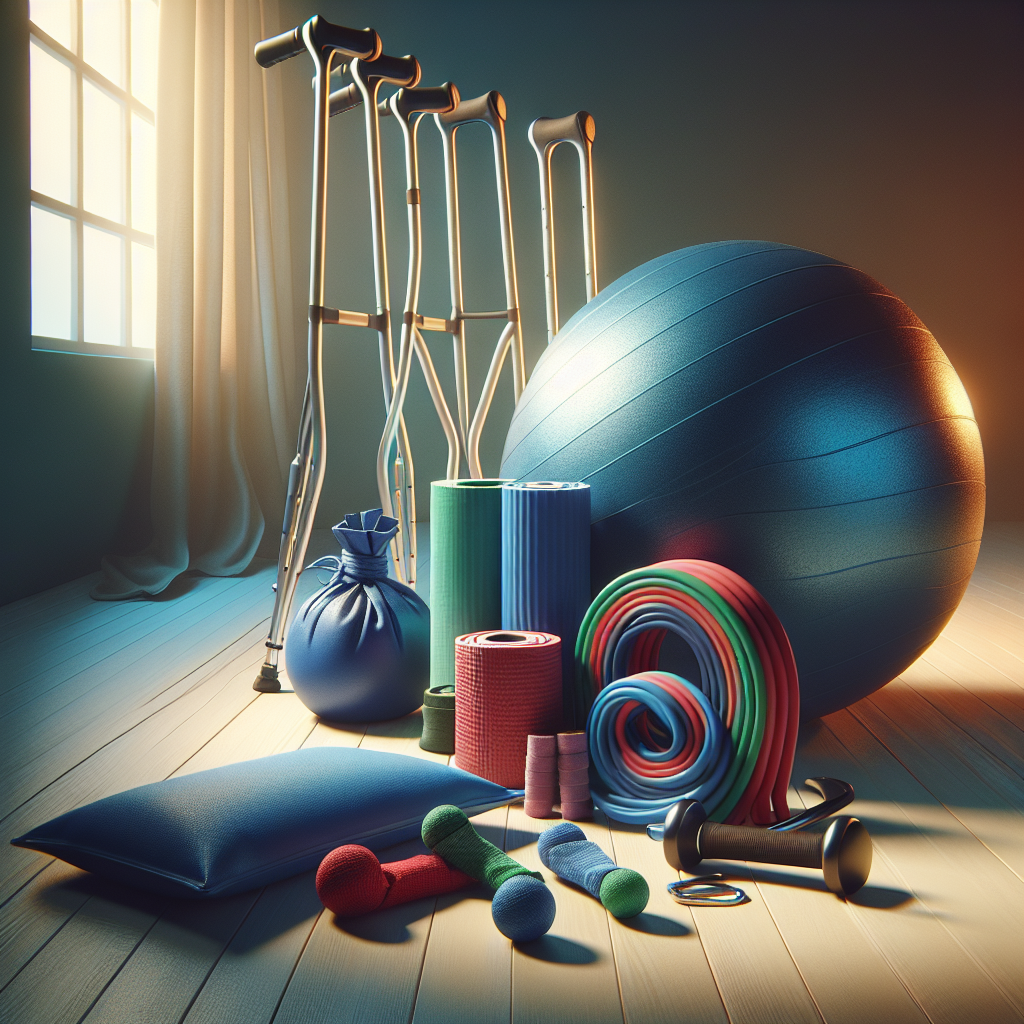In the realm of health and recovery, injury rehabilitation tools play a crucial role in aiding recovery and enhancing an individual’s performance. These tools are designed to address various aspects of rehabilitation, ensuring that patients receive the support they need tailored to their unique health situations. Understanding these tools is vital not only for patients but also for caregivers and health professionals who strive to provide the best care possible.
Rehabilitation tools come in many forms, each catering to specific injuries and recovery needs. Some of the most common types include:
- Therapeutic exercise equipment: Items like resistance bands and stability balls that help strengthen muscles and improve flexibility.
- Cold and heat therapy products: Hot packs and ice packs that aid in reducing inflammation and alleviating pain.
- Mobility aids: Devices such as crutches, walkers, and canes that assist individuals in moving safely during their recovery.
- Braces and supports: These provide stability to injured areas, allowing for a more secure healing process.
By incorporating these tools into a rehabilitation program, patients can experience a smoother recovery process, ultimately leading to better outcomes. Their importance cannot be overstated, as they not only facilitate physical healing but also contribute to psychological well-being by empowering patients with the ability to actively participate in their recovery.
To ensure you have access to the best tools available, order online here for convenient shopping and fast delivery! Visit Cart Health for all your injury rehabilitation needs.
Top Essential Tools for Effective Injury Rehabilitation

When it comes to injury rehabilitation tools, having the right equipment is critical for ensuring effective recovery. Here are some of the top essential tools that every patient and caregiver should consider incorporating into their rehabilitation routine:
- Resistance Bands: These versatile bands are perfect for strength training and can be used to target various muscle groups. They offer adjustable resistance levels, making them suitable for all stages of rehabilitation.
- Balance Boards: Ideal for improving stability and coordination, balance boards help patients regain their footing and enhance their proprioception, which is crucial after an injury.
- Foam Rollers: These tools assist in muscle recovery by promoting blood circulation and reducing muscle soreness. Foam rolling can alleviate tightness and improve flexibility.
- Ice and Heat Packs: An effective way to manage pain and inflammation, these packs can be used interchangeably depending on the phase of injury recovery. Ice is typically used to reduce swelling, while heat helps soothe stiff muscles.
- Stretching Straps: These straps are excellent for aiding in stretching exercises and improving flexibility. They allow patients to deepen their stretches safely.
Utilizing these tools can significantly enhance the rehabilitation process, allowing individuals to effectively address their specific injuries while promoting strength and mobility. By integrating these essential tools into a personalized rehabilitation plan, patients can work towards a full recovery with confidence.
How to Choose the Right Rehabilitation Tools

Selecting the appropriate injury rehabilitation tools can significantly influence the effectiveness of the recovery process. Here are some key considerations to keep in mind when making your choice:
- Assess Your Specific Needs: Every injury is unique, so it's essential to evaluate the specific requirements based on the type of injury and the stage of recovery. Consulting with a healthcare professional can provide clarity on what tools are most beneficial.
- Quality Matters: Invest in high-quality tools that are durable and reliable. Poor-quality equipment can lead to ineffective rehabilitation and may even exacerbate the injury. Look for trusted brands known for their medical-grade supplies.
- Ease of Use: Choose tools that are user-friendly and suitable for your skill level. Some tools may require guidance for proper use, so consider your comfort level and any necessary instructions.
- Portability: If you plan to rehabilitate on the go, opt for tools that are compact and easy to carry. Resistance bands and foam rollers, for example, are both lightweight and portable.
- Consult Reviews and Recommendations: Researching reviews and seeking recommendations from healthcare providers or fellow patients can offer insights into the effectiveness of various rehabilitation tools.
By considering these factors, you can make informed decisions that align with your rehabilitation goals, ultimately enhancing your recovery experience.
Injury Rehabilitation Tools for Home Use

Rehabilitating an injury at home can be both convenient and effective, especially with the right injury rehabilitation tools at your disposal. Here’s a look at some essential tools that are perfect for home use:
- Resistance Bands: These versatile bands come in various resistance levels, making them suitable for different stages of rehabilitation. They are ideal for strength training, flexibility, and improving range of motion.
- Foam Rollers: Foam rolling is an excellent technique for muscle recovery and tension relief. Using a foam roller can help alleviate soreness and improve circulation, which is crucial during the rehabilitation process.
- Therapy Balls: Stability balls or exercise balls can be used for core strengthening and balance exercises. They are especially beneficial for developing stability and coordination post-injury.
- Heat and Cold Packs: Managing pain and inflammation is vital in the rehabilitation process. Heat packs can help relax muscles, while cold packs are effective for reducing swelling and numbing pain.
- Balance Boards: These are fantastic for improving stability and proprioception. Balance boards can be particularly useful for lower limb rehabilitation, helping to enhance coordination and prevent future injuries.
Having these tools readily available at home not only promotes convenience but also encourages consistency in your rehabilitation routine, leading to better outcomes.
Innovative Technologies in Injury Rehabilitation

Recent advancements in technology have significantly transformed the field of injury rehabilitation. These innovative technologies not only enhance recovery processes but also provide engaging ways for patients to engage in their rehabilitation programs. Here are some groundbreaking technologies making waves in the rehabilitation landscape:
- Telehealth Services: With the rise of telehealth, patients can now receive consultations and follow-up care from the comfort of their homes. This convenience increases adherence to rehabilitation protocols while providing access to expert advice.
- Wearable Devices: Smartwatches and fitness trackers can monitor physical activity, heart rate, and progress during rehabilitation. These devices offer real-time feedback, encouraging patients to stay motivated and adhere to their recovery plans.
- Virtual Reality (VR): VR technology is being utilized to create immersive environments for rehabilitation exercises. This can be particularly effective in pain management and improving motor skills through engaging scenarios that distract from discomfort.
- Robotic Assistive Devices: Robotics is playing a vital role in rehabilitation, providing patients with assistance during exercises. These devices can help improve strength, coordination, and overall mobility by offering support tailored to individual needs.
- 3D Printing: Custom orthotics and prosthetics can now be produced using 3D printing technology, allowing for personalized support that fits the patient's specific anatomical requirements, enhancing comfort and functionality.
Utilizing these innovative technologies in injury rehabilitation can lead to more effective recovery strategies, making the journey to wellness more efficient and engaging for patients.
Maximizing Recovery with the Right Tools
Choosing the right injury rehabilitation tools is essential for maximizing recovery and ensuring that patients achieve their goals effectively. The combination of the right equipment and a tailored rehabilitation program can significantly impact healing times and overall outcomes. Here are some strategies to consider when selecting tools for rehabilitation:
- Assessment of Needs: Every individual's recovery journey is unique. Caregivers and health professionals should conduct thorough assessments to determine the specific needs of the patient, which will guide the selection of appropriate rehabilitation tools.
- Incorporating Variety: Utilizing a diverse range of tools can keep the rehabilitation process engaging and prevent stagnation. From resistance bands to balance boards, incorporating various equipment can address different aspects of recovery.
- Focus on Functionality: When selecting tools, consider those that enhance functional movement. Tools that mimic everyday activities will not only aid recovery but also prepare patients for a smoother transition back to their daily lives.
- Setting Realistic Goals: Equip patients with tools that align with their rehabilitation goals. Whether it's improving strength, flexibility, or coordination, having the right tools can encourage progress and boost motivation.
- Regular Monitoring: Utilize tools that allow for tracking progress over time. This feedback can guide adjustments in the rehabilitation program and help patients stay motivated as they witness their improvement.
By focusing on these strategies and utilizing the appropriate tools, individuals on the path to recovery can optimize their healing experience. Order online here for convenient shopping and fast delivery!









